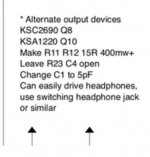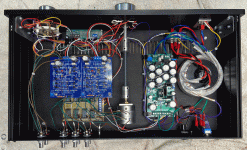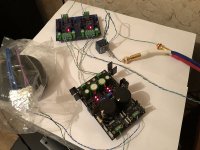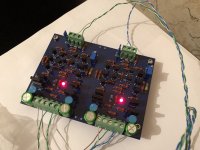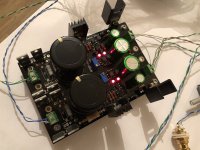As background and as a way to indicate the friendliness of my response I’ll confide that I took three years of Yoga classes, all at the beginner level. I feel there is too much to learn to go all advanced in a matter of weeks.
With a circuit board you could have done any number of things. Someone who has made the exact same mistake, experienced the same problem, might get you to a happy conclusion but it is really hard if one has not experienced the exact same problem.
My solution is not very satisfying for the problem solver in me, believe me I have been way over-the-top hard on myself for so many little mistakes. It got me far as an academic but as a repeat learner, now, I recommend repeating.
Order the whole kit again, identify and test every component before you make the iron hot. Plan the sequence of events and do the whole thing over again, painstaking each solder joint knowing for sure that each step was done properly. Clean every joint after making it. Make it a a kind of prayer. It’s good for you!
You may never discover what went wrong but you will teach yourself to do it right, that, after all, is the point ;-)
It is also a LOT less frustrating. It will take up less of your time and yields some serious happiness. Sometimes, in the process of doing it all slow and right, the mistake will make itself known, that’s just a bonus.
Cheers!
With a circuit board you could have done any number of things. Someone who has made the exact same mistake, experienced the same problem, might get you to a happy conclusion but it is really hard if one has not experienced the exact same problem.
My solution is not very satisfying for the problem solver in me, believe me I have been way over-the-top hard on myself for so many little mistakes. It got me far as an academic but as a repeat learner, now, I recommend repeating.
Order the whole kit again, identify and test every component before you make the iron hot. Plan the sequence of events and do the whole thing over again, painstaking each solder joint knowing for sure that each step was done properly. Clean every joint after making it. Make it a a kind of prayer. It’s good for you!
You may never discover what went wrong but you will teach yourself to do it right, that, after all, is the point ;-)
It is also a LOT less frustrating. It will take up less of your time and yields some serious happiness. Sometimes, in the process of doing it all slow and right, the mistake will make itself known, that’s just a bonus.
Cheers!
Just to check (and sorry for the blurry picture) but did you build the board using the components designed for headphone capability? If you just use it as a normal preamp to amp to speakers does all sound correct?I finished to solder my version of Wayne's LS this night.
Set DC out and tryed to listen with headphones.
There was a sound at the output but with distortion and also volume level was not even loud with LS connected directly to source.
Was dead tired to search what could go wrong and debug.
And I am still tired beacause I slept only a few hours.. 😴 So will only do simple measurements this evening.
A few suspicion things:
Both channels behave and sound the same.
LED's change brigtnes during music playback but not during playback of silence or tones.
My output transistors should dissipate 478 mW according to spice but they are barely warm.
I preset trimmers before solder from ltspice figures and DC out was only 0.01V and 0.04V and easily set to zero.
I did't have 0.1 mF film cap so I solder 0.01 mF. I hope this is not some kind of weird oscillation that goes berserk with music signal.
My headphone is low impedance, 40 Ohm.
Cheers
Attachments
Jdg123,
One little detail.
What member RainfallSky has built is his own version of Wayne’s linestage with his own layout off of KiCad. So I am curious to see if there were any errors in the Gerber files and such. Notice that his input stage doesn’t use the original SMD transistors (Q1-Q4, etc…) but TO-92 replacements.
I am sure we can figure stuff out once RainfallSky starts debugging and providing more details…such as voltages at various parts of the circuit with schematic representation.
Best,
Anand.
Order the whole kit again, identify and test every component before you make the iron hot. Plan the sequence of events and do the whole thing over again, painstaking each solder joint knowing for sure that each step was done properly. Clean every joint after making it. Make it a a kind of prayer. It’s good for you!
One little detail.
What member RainfallSky has built is his own version of Wayne’s linestage with his own layout off of KiCad. So I am curious to see if there were any errors in the Gerber files and such. Notice that his input stage doesn’t use the original SMD transistors (Q1-Q4, etc…) but TO-92 replacements.
I am sure we can figure stuff out once RainfallSky starts debugging and providing more details…such as voltages at various parts of the circuit with schematic representation.
Best,
Anand.
Yes, designed for headphone capability.Just to check (and sorry for the blurry picture) but did you build the board using the components designed for headphone capability? If you just use it as a normal preamp to amp to speakers does all sound correct?
Cheers
Will start to search for errors this evening after work.
I hope it's just a simple part or wiring mistake.
As always, please post a series of well-lit, in focus photos and we can start the debugging process.
There was no voltage between R11 R12.
I use 2SC4793 2SA1837 at the outputs.
Rechecking pinout it seems I solder them backwards.
KSC1845 is ECB and 2SC4793 is BCE...
Those was saved in my text files as the same pinout.
doh! 😵
Thanks everyone!
I use 2SC4793 2SA1837 at the outputs.
Rechecking pinout it seems I solder them backwards.
KSC1845 is ECB and 2SC4793 is BCE...
Those was saved in my text files as the same pinout.
doh! 😵
Thanks everyone!
Folks:
I spoke too soon. I recently finished a simple BA2018 preamp for a friend and have noticed a quiet 60 Hz buzz in the left channel. The hum is definitely coming from the preamp. The volume of the hum does not vary based on the selected input (the source selector relays also switch input grounds) or the position of the attenuator. All of the solder joints on the left channel have been reflowed, to no effect, and the wires seem properly dressed to me. I'm scratching my head here and would love some sage advice. But all suggestions and questions are appreciated!
Regards,
Scott
I spoke too soon. I recently finished a simple BA2018 preamp for a friend and have noticed a quiet 60 Hz buzz in the left channel. The hum is definitely coming from the preamp. The volume of the hum does not vary based on the selected input (the source selector relays also switch input grounds) or the position of the attenuator. All of the solder joints on the left channel have been reflowed, to no effect, and the wires seem properly dressed to me. I'm scratching my head here and would love some sage advice. But all suggestions and questions are appreciated!
Regards,
Scott
Attachments
MZM said recently, or long ago, "twist all wires that carry AC", which obviously includes signal leads. So, looks like both sets of the output wires are not twisted, nor are the wires to your volume control (which look a bit too long).
All good advice above. (Particularly twisting the in/out wiring)
A couple of easy-to-try things -
1) Loosen the bolt of the transformer and twist it left/right, see if there’s a quieter orientation.
2) Move the power feed wires out from under the corner if the amp pcb, I’d try moving the to the other side of the pot away from most everything, if you can.
A couple of easy-to-try things -
1) Loosen the bolt of the transformer and twist it left/right, see if there’s a quieter orientation.
2) Move the power feed wires out from under the corner if the amp pcb, I’d try moving the to the other side of the pot away from most everything, if you can.
Folks:
I spoke too soon. I recently finished a simple BA2018 preamp for a friend and have noticed a quiet 60 Hz buzz in the left channel. The hum is definitely coming from the preamp. The volume of the hum does not vary based on the selected input (the source selector relays also switch input grounds) or the position of the attenuator. All of the solder joints on the left channel have been reflowed, to no effect, and the wires seem properly dressed to me. I'm scratching my head here and would love some sage advice. But all suggestions and questions are appreciated!
Regards,
Scott
Front LED near ON/OFF knob is too close to AC wires and trafo.
Backlite knob is also right near AC input.
I would start from there.
Success!
Did a little test with headphone.
Grins, leg tapping, all is there. 😀
Did a little test with headphone.
Grins, leg tapping, all is there. 😀
Folks:
Thanks for the suggestions -- I'll be implementing many of them starting later on today. One small point: the hum can only be heard from the left channel and there is a shared power supply, so isn't it more likely that the problem exists somewhere within the portion of the preamp that is dedicated to just the left channel?
Regards,
Scott
Thanks for the suggestions -- I'll be implementing many of them starting later on today. One small point: the hum can only be heard from the left channel and there is a shared power supply, so isn't it more likely that the problem exists somewhere within the portion of the preamp that is dedicated to just the left channel?
Regards,
Scott
I may be wrong but it seems ground connection to your volume potentiometer wired strange.
Edit:
Sorry my mistake.
I thought it looked like input grouds route to potentiometer one channel ground but now I see they don't.
Edit:
Sorry my mistake.
I thought it looked like input grouds route to potentiometer one channel ground but now I see they don't.
Last edited:
It turns out I am too have a very low sounding buzz that could be heard on silence or even when source is turned off.One small point: the hum can only be heard from the left channel and there is a shared power supply, so isn't it more likely that the problem exists somewhere within the portion of the preamp that is dedicated to just the left channel?
Buzz is not related to potentiometer volume level but on high volume levels with silence track I start to hear a hum.

I suspect buz is related to grounding and/or reference GND. Mine right now doesn't even have a casing.
Folks:
All sorted! Thank you, very much, for the suggestions! For the record, I implemented and/or tested the following:
Unfortunately, after each change or test the hum persisted. All solder connections on the left channel were again reflowed. I could no longer clear the two output ground vias and was forced to connect the output grounds to the negative terminal on C5 and C12. Happily, that wasn't a problem.
It turns out the hum resulted from the way in which I connected the output grounds. The ground wires ran from the BA2018 to the outputs, where the two ground wires then connected to each other at the L and R outputs. The problem was that the preamp was connected to mono block amps. When I separated the ground wires (L channel ground solely to L output, R channel ground solely to R output) the hum vanished. I suppose the problem wouldn't have arisen with a regular stereo amp. Lucky me!
In any event, thank you, one and all, for the support!
Regards,
Scott
All sorted! Thank you, very much, for the suggestions! For the record, I implemented and/or tested the following:
- Rotated the toroid
- Moved the power feed wires further away from the BA2018 pcb
- Disconnected the power to the relay board (to assess whether the relay board was the problem)
- Swapped preamp outputs (to verify the problem did not lie in the amps, and yes the hum moved to the other channel)
- Twisted both the wires to the attenuator and the wires to the outputs
- Raised the BA2018 another 12mm away from the relay board
- Disconnected the wires between the attenuator and BA2018
It turns out the hum resulted from the way in which I connected the output grounds. The ground wires ran from the BA2018 to the outputs, where the two ground wires then connected to each other at the L and R outputs. The problem was that the preamp was connected to mono block amps. When I separated the ground wires (L channel ground solely to L output, R channel ground solely to R output) the hum vanished. I suppose the problem wouldn't have arisen with a regular stereo amp. Lucky me!
In any event, thank you, one and all, for the support!
Regards,
Scott
- Home
- Amplifiers
- Pass Labs
- Wayne's BA 2018 linestage
